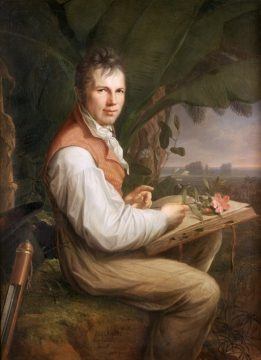Stephen Corry in Counterpunch:
Supreme art is a traditional statement of certain heroic and religious truths, passed on from age to age, modified by individual genius, but never abandoned. The revolt of individualism came because the tradition had become degraded, or rather because a spurious copy had been accepted in its stead.
– W.B. Yeats[1]
 Who’s the “father” of environmentalism? Now that the human impact on nature is getting more attention than ever, it’s a question worth asking. Is it, for example, the Prussian naturalist, Alexander von Humboldt, as his biographer thinks?[2] He was born in 1769, 250 years ago and isn’t big in the English-speaking world despite having more species named after him than anyone else in history. It’s not just species: A river, lake, bay, forest, and mountain ranges bear his name in the U.S. where few now know who he was. It’s different in Germany: Posterity has ensured “Humboldt” is plastered on streets, schools, universities, institutes and shops all over the country. Put “Humboldt” into Google Earth with any German city to see the effect.[3]
Who’s the “father” of environmentalism? Now that the human impact on nature is getting more attention than ever, it’s a question worth asking. Is it, for example, the Prussian naturalist, Alexander von Humboldt, as his biographer thinks?[2] He was born in 1769, 250 years ago and isn’t big in the English-speaking world despite having more species named after him than anyone else in history. It’s not just species: A river, lake, bay, forest, and mountain ranges bear his name in the U.S. where few now know who he was. It’s different in Germany: Posterity has ensured “Humboldt” is plastered on streets, schools, universities, institutes and shops all over the country. Put “Humboldt” into Google Earth with any German city to see the effect.[3]
Germans laud their famous sons. (They are, of course, almost all sons!) This long predates Hitler-worship,[4] as one of the oddest of European monuments testifies. Called “Walhalla,“ it’s a faux Greek temple, built by Bavarian King Ludwig I in the 1830s to house busts of famous Germans. Humboldt is in there together with his even more famous friend, Goethe. The two are as prominent to Germans as Darwin (who Humboldt met) and Shakespeare are in England. Big daddies just don’t come any bigger. So what did Humboldt actually father and should it matter now?
More here.
